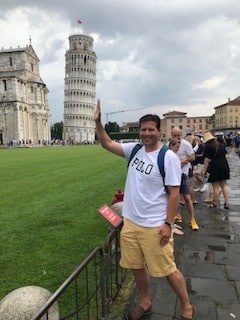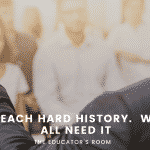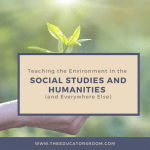Once in a while in the midst of life’s serpentine journey, the clockwork of life seems to slow for just a few moments. Something enormous and significant seems to swell within. Until very recently in human history, a person would describe this rare sensation as a rousing of “the soul,” an opening of the heavens, a momentary union with grandeur itself, perhaps a brief glimpse of spiritual enchantment where words like “inspiration” or “insight” are conceived.
Two days ago, I experienced one of these all-too-rare moments.
My family and I were visiting the Piazza dei Miracoli, located in Pisa, Italy. This is the famed walled area that contains the Leaning Tower of Pisa. In addition to the Leaning Tower, there are additional structures that elicit considerable attention including the Pisa Cathedral and the Pisa Baptistry. It should come as no surprise that as I made my way down the crowded path towards the Leaning Tower, almost all of my fellow tourists were taking pictures of the Leaning Tower—specifically, they were posing so that in the pictures they took it looked like they were holding up the Tower with their hands or even a single finger. (See my own version of this picture).
What caught my interest, however, was the Pisa Baptistry, a Catholic building that is unlike any structure I have ever witnessed in my life.
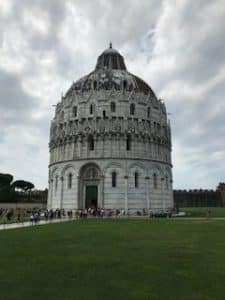
Designed by Diotsalvi in the 12thCentury, it took over two centuries to complete and can best be described as a circular dome building blending the architectural styles of both Romanesque and Gothic. What triggered my moment of wonderment was the fact that on the exterior of the Baptistry are dozens of small elevated statues of different men from the waist up. As I walked around the circular Registry, I looked at each of the statues for a moment.
The figures seemed to be looking down at (or on) me.
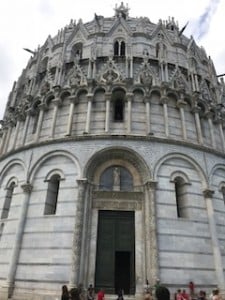 In this moment I was struck by two essential truths: first, these men did something so significant in their lives that they deserved to be memorialized on this historic building for the next seven centuries (and counting). But this insight then led me to a darker, more unsettling realization: I did recognize or know a single one of them.
In this moment I was struck by two essential truths: first, these men did something so significant in their lives that they deserved to be memorialized on this historic building for the next seven centuries (and counting). But this insight then led me to a darker, more unsettling realization: I did recognize or know a single one of them.
Millions and millions of people glimpse the busts of these men who lived long ago. I have a strong suspicion, however, that 99.9% of the visitors to the Piazza dei Miracoli are as ignorant of their identities as I was. To have one’s face as ornamentation on one of the most historic places on the entire planet would be exhilarating for most people, a compelling signifier that one lived a life of significance, of substance, of worldly consequence.
And yet, I was left guessing as to their true identity. Were they Christian saints? Were they leaders in the city of Pisa? Were they historic writers, artists, or warriors? The truth is, I’ll never know. Almost no one will ever know.
What is the lesson for our students?
What is the lesson for teachers?
It seems to me there is a profound insight to be discerned for those of us who spend our lives teaching young minds. The statues standing aloft on the perimeter of the Pisa Registry certainly occupy a majestic perch, august in their imminence, and by the modern benchmark of “views,” certainly impressive.
But the truth is these now-forgotten men almost certainly made the most difference in the lives of the people they lived amongst—fellow travelers in their own time and fellow citizens in their own communities. That they are now commemorated in such a spectacular fashion is incidental to the actual impact they had on the world as they knew it.
Thus, as I have aged, my ambitions have slowly been smoothed out and localized. They no longer look like ambitious alps or vainglorious peaks for all the world to see. Instead, I am increasingly convinced that the best lives we can hope for are not the ones end up chronicled in history books or chiseled onto the side of historic buildings in Italy. They are not the lives with 10 million Twitter followers, but are the ones that are worthy of a humble local statue, lives that are remembered in local parks, the one’s whose names grace local schools or streets, the ones who do not confuse wealth with riches or fame with significance.
University of Chicago Humanities professor Leon Cass tells us to consider the differing answers of three workers who were asked to describe the work they were jointly doing. “I’m just making a living,” said the first. “I’m dragging heavy stones,” said the second. The third proudly declared, however, “I’m building a cathedral.”
I would like to think that the teachers of the world are kindred souls with the third worker.
After all, the quotidian grind of modern teaching with its constant carousel of reform, its proliferating list of responsibilities, its never-ending attempts to fix every social malady, feels a lot more like dragging stones than it does building cathedrals or experiencing moments of purified wonderment. And the product of our classrooms, to use the nomenclature of a commercially-driven society, is not sold in a market, its value not derived by the intersectionality of buyers and sellers. Instead, what we as teachers achieve is microscopically imprinted on the heart and in the mind of every student we teach. It is not quantifiable in the traditional sense of the word but is measured in a more magical fashion: through the testimony of our students from long ago.
[bctt tweet=”Good teachers are like canonical books. They stay with us for reasons we can’t always articulate or identify.” username=””]
Good teachers are like canonical books. They stay with us for reasons we can’t always articulate or identify. In this sense, none of us are truly autodidacts. None of us are thoroughly “self-made” men or women. We are all walking on stones placed below us by people we know nothing of. The wisdom whispered to our profession by the statues of the Pisa Baptistry counsel us to find meaning in our classrooms, in our communities, in the chorus of students we spend our lives teaching.
But do not bother chasing the sands of history. They scatter. They are elusive. Most of all, they are ultimately unrecognizable through the ages.

